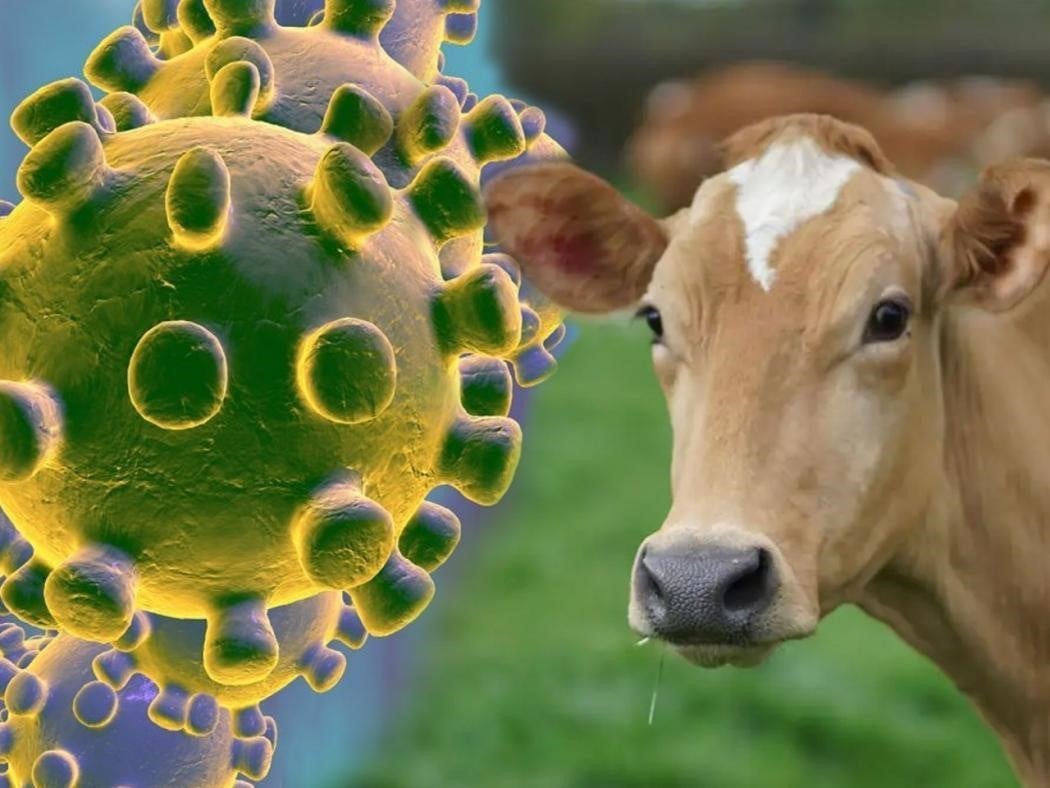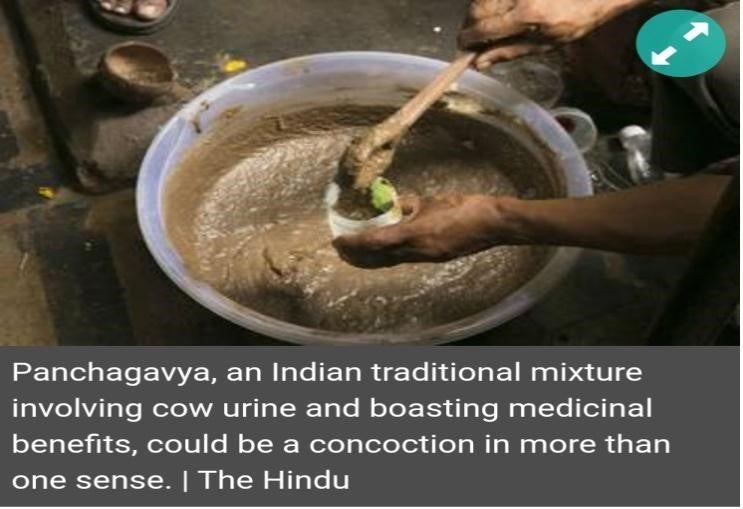Panchagavya, Gaumutra and Yoga: Re-inventing Hinduised Medical Practices in Times of Pandemic
contributed by Arijita Manna, 12 August 2020

The coronavirus has created a global crisis to which scientists have yet to give any decisive answer. Confronted with this huge danger, people are resorting to the repertoire of religion to cope with their anxiety and seek a meaning for the novel phenomenon, as well as for a panacea. Religious beliefs have responded to the crisis in a myriad of ways, from propitiating the pathogen, to identifying the malicious spreader community, and motivating social service. In India, one of the interesting and prominent phenomena during the pandemic has been the revival or re-invention of Hindu traditional medical practices to prevent and defeat the coronavirus. Although traditional medical practice has always been part of religious epistemology, these practices are being engaged only to exercise the political ideology of religious nationalism.
Gaumutra and Panchagavya: A Cure to Coronavirus
As the number of COVID-19 cases continued to increase in India, a handful of enthusiastic advocates of Hindutva (Hindu nationalism) started pitching the efficacy of the panchagavya (a concoction of the five products derived from a cow) and cow urine to prevent and cure the coronavirus. Soon after COVID-19 was declared a pandemic by the World Health Organization, Gaumutra (cow urine) parties were organised in different parts of India under the leadership of the All India Hindu Mahasabha. The organisers claimed that given the sacred nature of cows in Hinduism, only Indian cows have medicinal properties. For centuries, cow urine and cow dung have been used in the household for purification. These substances are said to be able to kill viruses in the air and in our body as well. A leader of the Akhil Bharat Hindu Mahasabha even proposed that all the world leaders should consider importing cow urine and cow dung from India. These activities received confirmation from the AYUSH Ministry (Ministry of Ayurveda, Yoga & Naturopathy, Unani, Siddha and Homoeopathy). An official of the ministry suggested to take a mouthful of a concoction consisting of cow urine, turmeric, salt and fennel seeds and stare at the sky for 5 to 7 minutes in order to kill the virus remaining in the mouth and throat area.

Figure 1: Panchagavya, a proposed medication for coronavirus. Source: The Hindu, 21st July 2017

Figure 2: A Cow Urine party organised to ward off coronavirus. Source: THEWEEK, 14th March 2020
The belief in the efficacy of panchagavya and gaumutra also found approval from prominent political figures of the ruling party as well. A member of the Legislative Assembly of Assam proposed cow urine and cow dung for treating the “deadly coronavirus”. In fact, in Sola Civil Hospital of Ahmedabad, twenty COVID-19 patients were given giloy gomutra capsules as part of a clinical trial. When asked about the efficacy of this medication, the chief physician of Neuropanch Ayurved Hospital in Gandhinagar, Gujarat contended that the coronavirus is a type of jvar (fever) which can be cured by panchagavya medicine as it has already been proved effective to cure various types of ailments. There is even an article published by physicians and consultants of Govigyan Anusandhan Kendra claiming “clinical improvement of COVID-19 patients” treated with panchagavya medicine.
Following Dinacharya to Prevent Coronavirus
Various Ayurvedic institutions around the world have prescribed some simple “dinacharya” (daily routine) in efforts to avoid being affected by the coronavirus. A New Mexico-based Ayurvedic institution recommended the following dinacharya, as has been suggested in the Caraka Samhita (a classical text of Ayurveda written in Sanskrit before the 2nd century CE) in times of outbreak of “janapada dhvamsa vyadhi” (which can be translated as pandemic): consumption of various herbs, eating only hot food and beverages, practicing pranayama and asanas, meditation with particular mantras, performing pujas and evening veneration rituals, clapping hands and playing drums during the puja - as this clapping sound would strengthen energy and would send a message to internal organs (doomasvaniaydahya) - and chanting the mantras Om or Jai Ganesh. It is interesting to note how the coronavirus, a novel pathogen, became analogous with the ancient textual category of “janapada dhvamsa vyadhi”. The more detailed discussion in the Charaka Samhita emphasises the need to search for aetiologies for the outbreak and on understanding the different phases of the disease cycle and the interventional measures to be employed at these different stages, but these aspects are being currently ignored. In place of these, a simplistic method of treating the symptoms through cow urine and panchagavya or preventive mechanisms such as following dinacharya are being popularised.
There is a broad-based application of terms selectively and conveniently taken from ancient texts to fit into the current situation, as well as a selective and idiosyncratic interpretation of these same texts. When combined with a foregrounding of the doctrinal or ritual aspects embedded in those texts and an avoidance of medicinal sensibilities, the interpretation does become problematic. Such goal-driven re-interpretation of ancient texts or knowledge systems resonates with the current political ideology of resurrecting the glorious Hindu past. In fact, a leader of the Rashtriya Swayamsevak Sangh, a Hindu nationalist organisation, called Ayurveda part of India’s "soft power" in the South Asian region. Thus Ayurveda, which embodies the indigenous knowledge system and has been composed over centuries and contributed to by a number of non-brahmin scholars, is being stripped of its pluralist matrix and being portrayed as essentially an Hindu knowledge system. The outbreak of the coronavirus gave momentum to the process of reducing the indigenous knowledge system to an instrument of religious nationalism.
The Power of Yoga
In addition to cow urine and cow dung, practicing yoga was also encouraged to prevent the coronavirus. This claim received approval from the Chief Minister of Uttar Pradesh, as well as from the Prime Minister himself. Yoga certainly provides health benefits, but to claim that yoga can cure COVID-19 is based on and perpetuates misinformation. Popular Indian yoga guru Swami Ramdev in his sensational show titled “Corona se jang, Swami Ramdev ki sang” (Fight against corona with Swami Ramdev) broadcast by the IndiaTV channel, claimed that performing pranayam, asanas such as sun salutations, as well as consumption of recommended herbal concoction can cure COVID-19 positives so much that no “symptomatic medication” would be required. Through his YouTube channel and others such as Astha TV and Sanskar TV, he continued to propagate the power of yoga, Ayurveda, Karmayoga, wisdom of the ancient sages, and the uniqueness of Bhartiya Samskriti (Indian Culture), which would make India the world leader in this battle against the coronavirus.

Figure 3: Yoga guru Swami Ramdev’s show to fight against coronavirus. 31st May 2020. Source: Youtube
These shows are replete with doctrinal and ritual references from Hindu religious tradition - ignoring the pluralist matrix of yoga (influences from Buddhism, Sufism, Jainism, Tantra and Natha traditions) and thus work for promoting the nationalist narrative of cultural superiority of Hinduism. The guru suggests chanting Om or Gayatri mantra while performing pranayam for chanting Om in every breath increases the efficacy of these asanas. This raises a concern of whether the efficacy of yoga is tied to the performance of chanting. This concern becomes relevant when led along with culturally discriminatory statements such as "Nagas can’t sit lotus style", which was made by a yoga teacher of Patanjali Yoga Trust (Nagaland).
Reiteration of medication prepared from cow derivatives and efficacy of yoga to cure the coronavirus clearly shows how the pandemic has become instrumental in shaping popular perception of the cultural past to match the ideologies of Hindutva, and in shaping the present society as well.
References
Anderson, Edward. Longkumer, Arkotong. (Eds) Neo-Hindutva: Evolving Forms, Spaces, and Expressions of Hindu Nationalism, Routledge, New York, 2020.
Puri, Jyoti. “Sculpting the Saffron Body Yoga, Hindutva, and the International Marketplace” in Angana P Chatterji, Thomas Blom Hansen., Christophe Jaffrelot, (Eds.) Majoritarian State: How Hindu Nationalism Is Changing India, Harper Collins, 2019.
Stewart, Katherine. The Power Worshippers: Inside the Dangerous Rise of Religious Nationalism, Bloomsbury, New York, New Delhi, 2020.
Wujastyk, Dagmar. Smith, Frederick M. (Eds) Modern and Global Ayurveda: Pluralism and Paradigms, SUNY Press, Albany, 2013.
Arijita Manna is a PhD Research Student in the Department of History of Jadavpur University, Kolkata, India. Her area of research interest is Trade and Commerce in Eighteenth and Nineteenth Century Bengal. Institution: Jadavpur University, www.jaduniv.edu
Disclaimer: The views and opinions expressed in this article are those of the authors and do not necessarily reflect the position of the blog editorial team or the Asia Research Institute.
South Asia | Southeast Asia | East Asia | Other Places | Hinduism | Buddhism | Islam | Christianity | Other Religions



